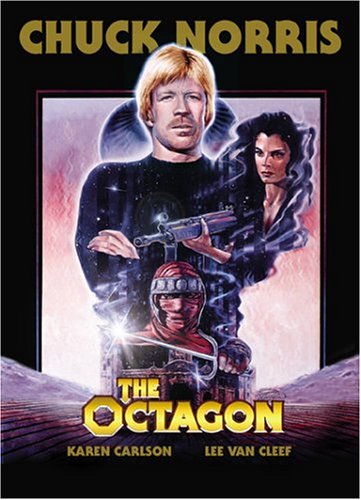If there’s one take-home message to be learned from revisiting 1980’s “The Octagon,” is that we should perhaps revisit a lot of the ninja-centric movies we’ve written off over the years. Predating true genre classics such as “Enter the Ninja,” “Revenge of the Ninja,” and well, pretty much anything attached to Sho Kosugi from the 80’s, “The Octagon” offers b-movie buffs one of the first true Chuck Norris solo vehicles. It also offers one of the most arduous 108 minutes of film that the genre has ever seen. What makes “The Octagon” so infuriating to experience is its general level of competence and technical kill in most filmmaking categories, with a bevy of mediocre, but never truly terrible performances cobbled together from a truly banal exercise in screenwriting. And yes, this is a movie about ninjas we’re talking about.
“The Octagon” doesn’t actually serve up any truly great ninja action until its somewhat redeemable final act; the preceding two acts coast along at an unnaturally leisurely pace weaving an needlessly complex plot and introducing more than a handful of supporting characters who generally blend into a morass of early 80s mediocrity. Among them, Kim Lankford, as Nancy who gets the plot going with an unhealthy obsession with international terrorism and the assassination game; sure enough right after conveying these fears to our hero, Scott James (Norris), she’s killed by, yes, you guessed it, Frank Stallone…err…ninjas. Writers Paul Aaron and Leigh Chapman use this key plot development to get our hero into the ninja game, although that doesn’t occur for roughly another hour, as we need to cut to bizarre side plots, most memorably training sequences at a mysterious ninja compound, full of the saddest looking future ninja stock, pre-Matt Hanon’s tour-de-force performance in “Samurai Cop.”
I really tried my best to tear apart “The Octagon” on the classic b-movie level, but to his credit, director Eric Karson turns in a generally slick looking movie and despite a horribly bloated script, the film does logically flow from scene to scene. That’s not to say there aren’t a few stylistic choices that earn the film justified comedic derision. While we may not be getting local theater level performances, what we lack in odd acting quantity, we get in quality from our film’s star; Norris is firing on all the proper Norris cylinders here, delivering his lines with the trademark disinterested lack of emotion that propelled him to the Golan-Globus Hall of Fame in years to come. If that wasn’t enough, someone thought it would be a bright idea to give his character an inner monologue, but not just standard narration; no, we get even more Norris readings in a creepy reverb rich, post-production nightmare that can’t be taken with a straight face for even a fraction of a second
Fortunately, we do indeed get some ninja action “The Octagon” finally delivers the b-movie goods well into its latter half. With the earlier added revelation that the leader of our antagonists is Scott’s estranged half-brother, there’s a base-level tension and sense of urgency to the impending showdown. Viewers not only get Norris’ legitimately exciting brand of martial arts, but also that of co-stars Tadashi Yamashita and Richard Norton, two very legitimate martial artists and genre stars in their own right. The strength of “The Octagon’s” finale is reason enough to recommend it for at minimum, a rental; there’s no excuse possible for the film’s generally sloppy structure and unwillingness to properly engage its audience, but its place in genre history is deserved, if only for serving as the catalyst to the ninja craze that continues to this day.

